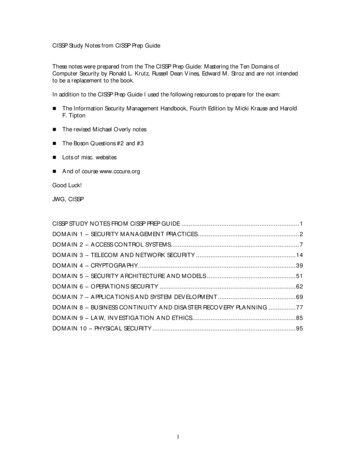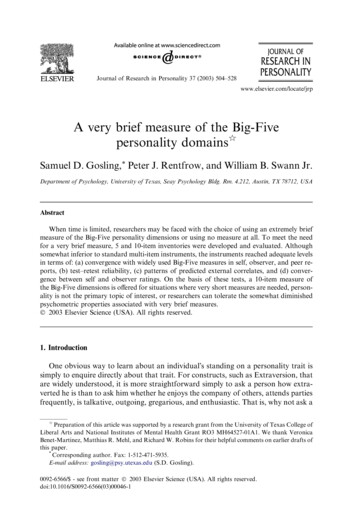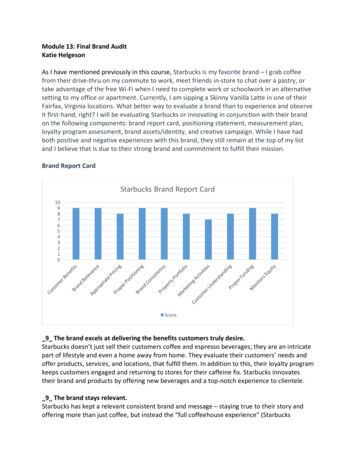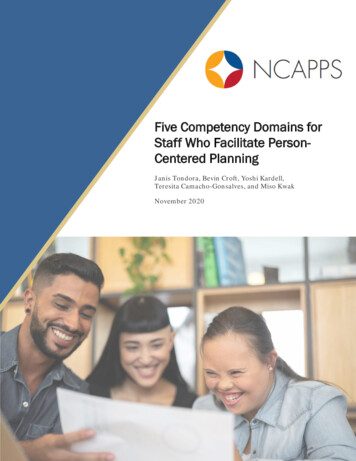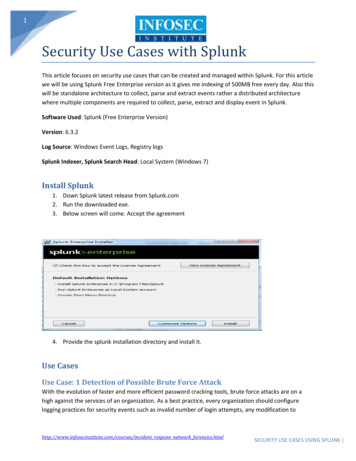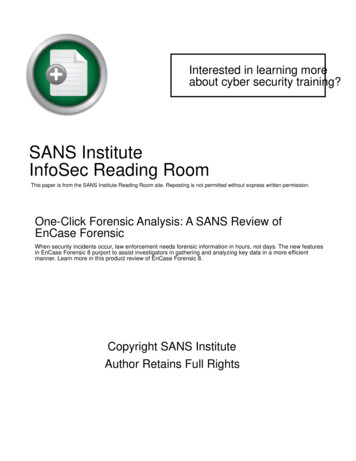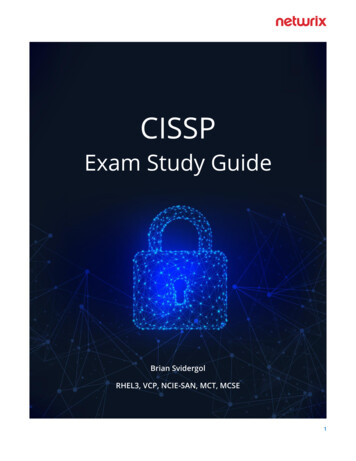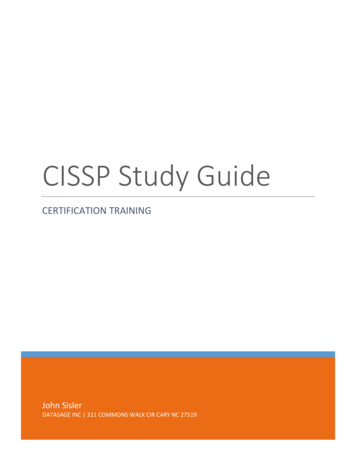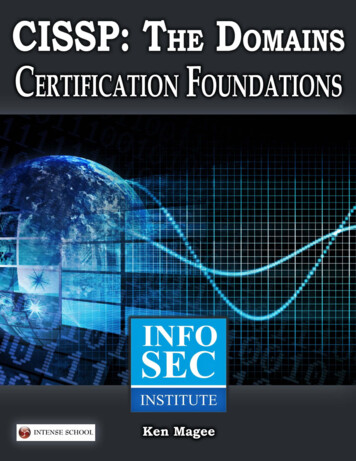
Transcription
CISSP: The DomainsInfoSec Institute – Certification Foundations
Table of ContentsINTRODUCTION4DOMAIN 1: ACCESS CONTROLWHAT’S NEW IN ACCESS CONTROL?AN OVERVIEW557DOMAIN 2: SOFTWARE DEVELOPMENT SECURITYWHAT’S NEW IN APPLICATIONS SECURITY (NOW SOFTWARE DEVELOPMENT SECURITY)?AN OVERVIEW9910DOMAIN 3: BUSINESS CONTINUITY & DISASTER RECOVERYWHAT’S NEW?AN OVERVIEW121213DOMAIN 4: CRYPTOGRAPHYWHAT’S NEW?AN OVERVIEW171718DOMAIN 5: INFORMATION SECURITY GOVERNANCE & RISK MANAGEMENTWHAT’S NEW?AN OVERVIEW212122DOMAIN 6: LEGAL, REGULATIONS, INVESTIGATIONS, AND COMPLIANCEWHAT’S NEW?AN OVERVIEW242426DOMAIN 7: SECURITY OPERATIONSWHAT’S NEW?AN OVERVIEW282829DOMAIN 8: PHYSICAL & ENVIRONMENTAL SECURITYWHAT’S NEW?AN OVERVIEW323233DOMAIN 9: SECURITY ARCHITECTURE & DESIGNWHAT’S NEW?AN OVERVIEW363638DOMAIN 10: TELECOMMUNICATIONS & NETWORK SECURITYWHAT’S NEW?AN OVERVIEW404041INFOSEC INSTITUTE’S CISSP BOOT CAMPCOURSE OVERVIEWCOURSE SCHEDULE444445
SC)²’s CISSP Exam covers ten domains which are: Access ControlApplication Development SecurityBusiness Continuity and Disaster Recovery PlanningCryptographyInformation Security Governance and Risk ManagementLegal regulations, investigations, and complianceOperations SecurityPhysical and Environmental SecuritySecurity Architecture and DesignTelecommunications and Network SecurityOver the course of the this eBook, we’ll take a look at each one of the domains; give you someinsight into what (ISC)² is looking for in that area; give you some supplemental readingmaterial; and by the time we’re done, you should have the foundation of the information you’llneed to pass the CISSP exam as well as to succeed in your security professional career. Youwill go into your CISSP boot camp well-prepared and come out with your certification!I will say this, one of the ways that you can ensure your preparation for the CISSP exam is bytaking the InfoSec CISSP Boot Camp course. As far as reading material is concerned, everyoneshould have their own personal copy of the CISSP CBK 2nd Edition from (ISC)². All quotedmaterial in this guide is from the “Official (ISC)2 Guide to the CISSP CBK Third Edition.”A QUICK NOTE ON FORMATTING:ISC2 published the 3rd edition of their CISSP CBK in late 2012. I ordered my copy inDecember 2012 and said, “So what’s new?” Each of the 10 domains is a chapter, and eachchapters starts off with a “what’s new” section. So if you’ve studied up in the past or are partway through previous material, it will be beneficial to at least read through the beginnings ofeach of the chapters.4
www.infosecinstitute.com866-471-0059DOMAIN 1:ACCESS CONTROL“Instructor used a good blend of instruction, humor and testing. I liked how he tookhis time (and made us take our time) on review questions so that everyone had a chanceto ask questions and understand why something was right or wrong. Greatexperience!”Betsy PowlenLogis-TechWHAT’S NEW IN ACCESS CONTROL?I started going through the Access Control domain and these are some of the changes that Ifound: For “Personnel Security, Evaluation, and Clearances” and additional source ofinformation for staff verification has been added. “ An online search of publiclyavailable information on social media sites ” A whole section has been added for “Session Management” and includes two majorareas:1) Desktop Sessions and 2) Logical Sessions. The Desktop Session section had severalsub-sections including:o Screensaverso Timeouts and Automatic Logoutso Session/Logon Limitationo Schedule LimitationsAn interesting addition as a key point to remember about Kerberos was added, it reads,“.Kerberos processes are extremely time sensitive and often require the use of Network TimeProtocol (NTP) Daemons to ensure times are synchronized. Failure to maintain a5
www.infosecinstitute.com866-471-0059synchronized time infrastructure will lead to authentication failures. This can be an attractivevector for a DOS attack.”There’s a new section on Security Information and Event Management. It goes into somedetail with respect to log management and something that I’ve been saying for several yearsand that is “near real time” management of security information.Spyware has been expanded to identify and discuss “Malvertisements” and “Malnets.”Threat Modeling has gotten its own section, including some specific steps for organizationsto take as an approach. Those steps include: Define the Scope and ObjectivesUnderstanding or Modeling the SystemDevelopment of ThreatsDevelopment of VulnerabilitiesDetermining Impacts and RiskDevelop a Mitigation PlanWe use to see this strategy as part of Business Impact Analysis and Risk Assessment but it hasbeen moved to Access Control. That is also true for “Asset Valuation” which has been movedto Access Control and includes: HardwareSoftwareIntegrationOpportunity CostsRegulatory ExposureInformation ReplacementReputational ExposureAlso included in this section are the calculations for SLE and ALE which we use to find inthe Risk domain.The last two major areas, which received additional coverage includes, “Access Review andAudit” and “Identity and Access Provisioning Lifecycle.”6
www.infosecinstitute.com866-471-0059Of course along with any change you get re-sequencing, font size change, bolded emphasis,and the occasional colorful metaphor. All-in-all, I’m pleased with the revisions to this domainand I look forward to the other nine.InfoSec Institute is in the process of updating their CISSP curriculum and where appropriatewill include coverage of any new material which is included in the new CISSP CBK.AN OVERVIEWThere are several areas within access control which are covered on the CISSP exam. Thoseareas include IAAA (Identification, Authentication, Authorization and Accountability), accesscontrol techniques & technologies, administration, control methods, control types,accountability, control practices, monitoring and threats to access control. This article dealsspecifically with the role based access control model (RBAC). RBAC’s usage is widespreadacross all industries; allows organizations to address securing access control; and RBAC isreceiving an increased interest from (ISC)² in terms of questioning the knowledge the CISSPcandidate has relative to RBAC.Role based access control presents a unique opportunity for organizations to address theprinciple of Least Privilege, which is giving an individual only the access they need to do theirjob since the access is tied to their job. In a Windows or UNIX/Linux environment this istypically done by developing Groups. The Group has individual file permissions and eachindividual is then assigned as a member of that Group. At the same time however,organizations need to periodically review the role definitions and have a formal process inplace to modify roles and to test for segregation of duties. Otherwise without monitoring andreview there is a possibility that Role Creep will develop where an individual, say as anAccounts Payable clerk who had membership in the group which could add vendors istransferred to another job within AP and now is responsible for entering invoices. Withoutreview, that individual could now have both roles and could add vendors as well as enterinvoices for the same vendors. Not a good segregation of duties.David Ferraiolo and Rick Kuhn in their book Role Based Access Control proposed the RBACmodel based on the premise that it reduces the overall cost of maintaining secure access control.7
www.infosecinstitute.com866-471-0059That model has since been adopted as an ANSI/INCITS standard. ANSI/INCITS 359-2004standard.Role based access control is not a mandatory access control (MAC) nor is it a discretionaryaccess control (DAC). (MAC) refers to a type of access control by which the operating systemcontrols access to the information. This is typically done by the OS system administrator whenthe OS is configured, for example, which programs need to have administrative privileges torun. DAC is an access control similar to the traditional Unix system of users, groups, and readwrite-execute permissions where the owner controls who has access to the information. WithRBAC, access is assigned to users based on the job they have, or the role they play in theorganization. For example, when a person working as an Accounts Payable Clerk is promotedto an Accounts Receivable Clerk their access to the Accounts Payable system is changed. It isnot done screen by screen, file by file or drive by drive, but as a group based on their new job,or role. Some accesses may be eliminated but others are likely granted.When that individual is terminated or transferred, the security administrator simply removesthe assigned role, thus removing all of that individual’s access for the previous role. This alsoanswers the question of least privilege, since the assignment is role-based and not individualbased. This might appear to be more work rather than less work. This is true for the initialsetup. However, once the system/data owners have identified the different roles then it is amatter of assigning different roles rather than individual file or data access.The National Institute of Standards and Testing (NIST) administers RBAC. If you areinterested in reading further about RBAC, there is news, case studies, and help inimplementing the standard on their site at: http://csrc.nist.gov/groups/SNS/rbac/NIST is currently investigating revising the RBAC standard. To become involved indeveloping this important standard, check out: revision.html8
www.infosecinstitute.com866-471-0059DOMAIN 2:SOFTWARE DEVELOPMENT SECURITY“I would certainly recommend to my co-workers. truly outstanding!!”Douglas JonesDefense Threat Reduction AgencyWHAT’S NEW IN APPLICATIONS SECURITY (NOW SOFTWARE DEVELOPMENT SECURITY)?So what’s new in Software Development Security, besides the apparent name change fromApplication Security?I started going through this domain and other than some re-sequencing, only found two minorchanges. Web Application Threats and Protection section, got an extra paragraph whichidentifies the Open Web Application Security Project (OWASP) and their guides forweb app development. The Certification and Accreditation section, received an extra paragraph, outliningseveral reasons why a private organization may choose to undergo a formalauthorization process.All-in-all it appears to me that the biggest change, apart from the name change, was some resequencing.9
www.infosecinstitute.com866-471-0059AN OVERVIEWApplication development security requires an awareness of how different environmentsdemand different security. For example, the security for running a mainframe application thatis not accessible by anything except the mainframe would be considerably different than thesecurity for a web based application that anyone on the internet has access to. Other importantquestions that impact the application’s security include: How complex an application is it?What are the data types, formats, and lengths? What are the failure states? Which databasemanagement system is being used? All of these questions will impact the application’s security.I would be remiss if I didn’t mention system development life cycle, or SDLC. You will needto remember all those phases from feasibility through operations. As well as the ideas ofprototyping, rapid application development (RAD), joint application development (JAD), andbad application development (BAD). Just kidding on the last one. However, if you run shortof time there’s always Agile and CASE to speed up the process.(ISC)2 is showing a lot of interest in three areas within Application Development Security:Web Security, Mobile Code and Patch Management. Let’s take a closer look at each.Let’s examine Web Security first. A lot of the application code being developed today revolvesaround the internet. The InfoSec Institute has an excellent course in Web ApplicationPenetration Testing, during which you will learn not only how to attack but also how to defendyour Web Application. Web Application Security includes DoS (Denial-of-service) attacks,web application firewalls IDSs and IPSs. OWASP and SANS both, list Web Applicationvulnerabilities in the top 10. As is the case with any application development effort, you needto remember three things: 1) Always validate your input, this is especially critical in webapplications development when we look at vulnerabilities like cross-site scripting and SQLinjection, 2) Always validate the data during processing, and finally 3) always validate theoutput data. Also in web application development how you manage your session and whetheryou choose to use cookies or not needs to be carefully considered and the risks weighed againstthe business needs.Any discussion of Mobile code should include subjects like Java Applets, ActiveX Controls,Malware, Antivirus Software, Spam Detection software and others. All of these representpotential weaknesses in your application security, whether it’s choosing to include JavaScriptor Python script in your development of applets or ActiveX controls for your application or10
www.infosecinstitute.com866-471-0059whether it’s deciding if you want to make your code truly mobile with an iPad version. Thesame as with web application development, mobile code development needs to have avulnerability scan ran against the code before it’s put into production.And finally, Patch Management is an area that is relatively easy to address, but is oftenoverlooked. Every organization should have a patch management policy and all systems,including systems under development should be “patched.” Let’s face it, there are a lot of ITfolks out there as well as some non-IT folks who are doing system development. And that’sin all areas; application, operating system, database, network communication, etc.In application development secu
will go into your CISSP boot camp well-prepared and come out with your certification! I will say this, one of the ways that you can ensure your preparation for the CISSP exam is by taking the InfoSec CISSP Boot Camp course. As far as reading material is concerned, everyone should have their own personal copy of the CISSP CBK 2nd Edition from (ISC)². All quoted material in this guide is from .
